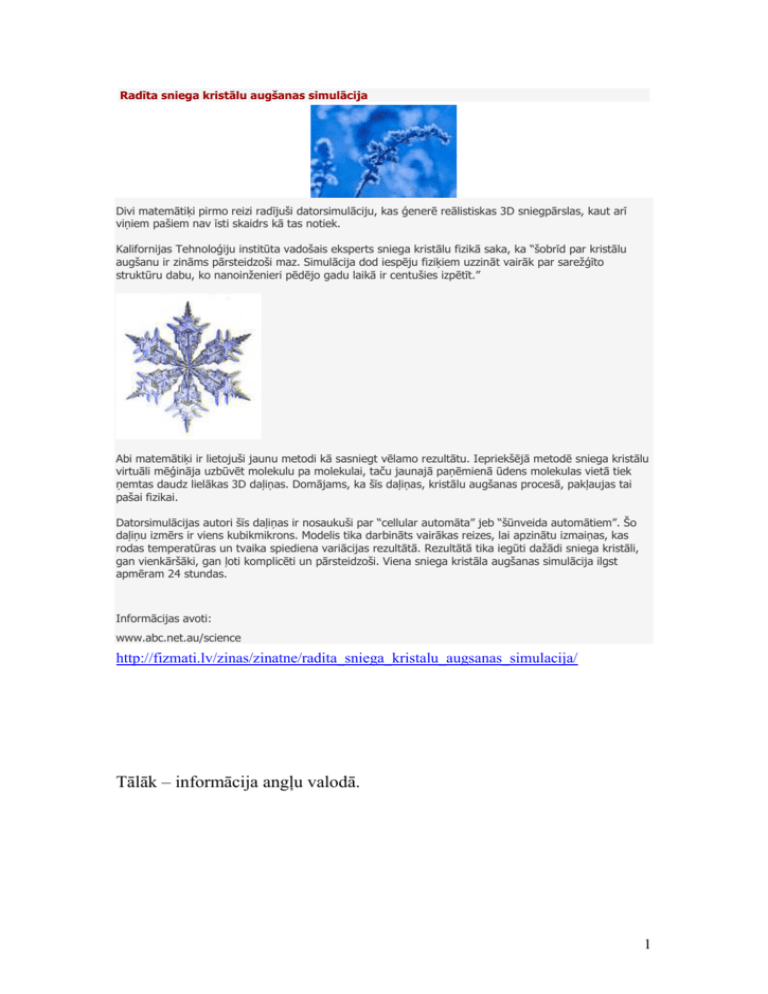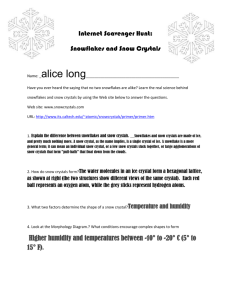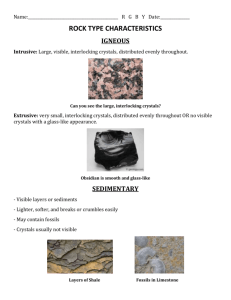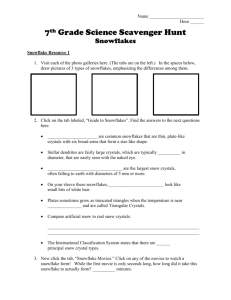Radīta sniega kristālu augšanas simulācija (5)
advertisement

Radīta sniega kristālu augšanas simulācija Divi matemātiķi pirmo reizi radījuši datorsimulāciju, kas ģenerē reālistiskas 3D sniegpārslas, kaut arī viņiem pašiem nav īsti skaidrs kā tas notiek. Kalifornijas Tehnoloģiju institūta vadošais eksperts sniega kristālu fizikā saka, ka “šobrīd par kristālu augšanu ir zināms pārsteidzoši maz. Simulācija dod iespēju fiziķiem uzzināt vairāk par sarežģīto struktūru dabu, ko nanoinženieri pēdējo gadu laikā ir centušies izpētīt.” Abi matemātiķi ir lietojuši jaunu metodi kā sasniegt vēlamo rezultātu. Iepriekšējā metodē sniega kristālu virtuāli mēģināja uzbūvēt molekulu pa molekulai, taču jaunajā paņēmienā ūdens molekulas vietā tiek ņemtas daudz lielākas 3D daļiņas. Domājams, ka šīs daļiņas, kristālu augšanas procesā, pakļaujas tai pašai fizikai. Datorsimulācijas autori šīs daļiņas ir nosaukuši par “cellular automāta” jeb “šūnveida automātiem”. Šo daļiņu izmērs ir viens kubikmikrons. Modelis tika darbināts vairākas reizes, lai apzinātu izmaiņas, kas rodas temperatūras un tvaika spiediena variācijas rezultātā. Rezultātā tika iegūti dažādi sniega kristāli, gan vienkāršāki, gan ļoti komplicēti un pārsteidzoši. Viena sniega kristāla augšanas simulācija ilgst apmēram 24 stundas. Informācijas avoti: www.abc.net.au/science http://fizmati.lv/zinas/zinatne/radita_sniega_kristalu_augsanas_simulacija/ Tālāk – informācija angļu valodā. 1 Snowflakes - sniegpārsliņas Snowflakes and snow crystals are made of ice. A snow crystal is a single crystal of ice. A snowflake can mean an individual snow crystal, or a few snow crystals stuck together, or large agglomerations of snow crystals that form "puff-balls" that float down from the clouds. A snowflake is an aggregate of typically hexagonally symmetrical ice crystals. The most basic form of a snow crystal is a hexagonal prism. When snow crystals are very small, they are mostly in the form of simple hexagonal prisms. But as they grow, branches sprout from the corners to make more complex shapes. A snowflake always has six symmetric arms (along three symmetric axes), which arises from the hexagonal crystal structure. By growing snow crystals in the laboratory under controlled conditions, one finds that their shapes depend on the temperature and humidity. Thin plates and stars grow around -2 C (28 F), while columns and slender needles appear near -5 C (23 F). Plates and stars again form near -15 C (5 F), and a combination of plates and columns are made around -30 C (-22 F). Snow crystals tend to form simpler shapes when the humidity is low, while more complex shapes appear at higher humidities. The most extreme shapes form when the humidity is especially high. Snowflakes are not frozen raindrops. Sometimes raindrops do freeze as they fall, but this is called sleet. Sleet particles don't have any of the elaborate and symmetrical patterning found in snow crystals. Snow crystals form when water vapor condenses directly into ice, which happens in the clouds. The patterns emerge as the crystals grow. Types of Snowflakes Simple Prisms A hexagonal prism is the most basic snow crystal. Depending on how fast the different facets grow, snow crystal prisms can appear as thin hexagonal plates, slender hexagonal columns, or anything in between. Stellar Plate These common snowflakes are thin, plate-like crystals with six broad arms that form a star-like shape. Their faces are often decorated with amazingly elaborate and symmetrical markings. Sectored Plates Stellar plates often show distinctive ridges that point to the corners between adjacent prism facets. When these ridges are especially 2 prominent, the crystals are called sectored plates. The simplest sectored plates are hexagonal crystals that are divided into six equal pieces, like the slices of a h e x a g o n a l pie. More complex specimens show prominent ridges on broad, flat branches. Stellar Dendrites Dendritic means "tree-like", so stellar dendrites are plate-like snow crystals that have branches and sidebranches. These are fairly large crystals, typically 2-4 mm in diameter, that are easily seen with the naked eye. S t e l l a r dendrites are clearly the most popular snow crystal type, seen in holiday decorations everywhere. Fernlike Stellar Dendrites Sometimes the branches of stellar crystals have so many sidebranches they look a bit like ferns, so we call them fernlike stellar dendrites. These are the largest snow crystals, often falling to earth with diameters of 5 mm or more. In spite of their large size, these are single crystals of ice. 3 Hollow Columns Hexagonal columns often form with conical hollow regions in their ends, the two hollow regions are symmetrical. These crystals are small, so you need a good magnifier to see the hollow regions. Sometimes the ends grow over and enclose a pair of bubbles in the ice. Needles Needles are slender, columnar ice crystals that grow when the temperature is around -5 C (23 F). These snowflakes look like small bits of white hair. Capped Columns These crystals first grow into stubby columns, and then they the growth becomes plate-like. The result is two thin, plate-like crystals growing on the ends of an ice column. . Double Plates / Dupla lapocskák A double plate is basically a capped column with an especially short central column. The plates are so close together that inevitably one grows out faster and shields the other from its source of water vapor. The result is one large plate connected to a much smaller one. These crystals are common, many snowflakes that look like ordinary stellar plates are actually double plates if you look closely. Split Plates and Stars / These are forms of double plates, except that part of one plate grows large along with part of the other plate. The all eight a split star. picture shows ways to make 4 Triangular Crystals Plates sometimes grow as truncated triangles when the temperature is near -2 C (28 F). If the corners of the plates sprout arms, the result is an odd version of a stellar plate crystal. These crystals are relatively rare. 12-Sided Snowflakes Sometimes capped columns form with a twist, a 30degree twist to be specific. The two end-plates are both six-branched crystals, but one is rotated 30 degrees relative to the other. This is a form of crystal twinning, in which two crystals grow joined in a specific orientation. Bullet Rosettes The nucleation of an ice grain sometimes yields multiple crystals all growing together at random orientations. When the different pieces grow into columns, the result is called a bullet rosette. These polycrystals often break up to leave isolated bulletshaped crystals. Sometimes a bullet rosette can become a capped rosette. When the pieces of a polycrystal grow out into dendrites, the result is called a radiating dendrite or spatial dendrite. 5 Rimed Crystals Clouds are made of countless water droplets, and sometimes these droplets collide with and stick to snow crystals. The frozen droplets are called rime. All the different types of snow crystals can be found decorated with rime. When the coverage is especially heavy, so that the assembly looks like a tiny snowball, the result is called graupel. Irregular Crystals The most common snow crystals by far are the irregular crystals. These are small, usually clumped together, and show little of the symmetry seen in stellar or columnar crystals. Artificial Snow Artificial snow is made of frozen water droplets, with none of the elaborate structure found in real snow crystals. Snowcrystals seen with electron microscope / Avots: http://www.its.caltech.edu/~atomic/snowcrystals/ 6








